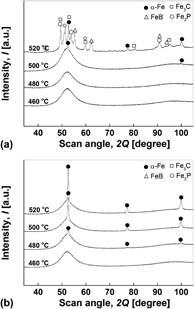Published online by Cambridge University Press: 10 March 2015

Cast-iron (CI) based bulk amorphous alloy with compositions of Fe75.5−xC6.0Si3.3B5.5P8.7Cu1.0Alx (x = 0, 1 at.%) was synthesized by Cu mold casting. As indicated by increased critical diameters (dmax) for the amorphization, the substitution of Al enhanced the glass-forming ability of the alloy. However, the onset temperature of crystallization (Tx) and the range of supercooled liquid region (ΔTx) of the alloy decreased upon Al addition from 500 °C and 28 °C to 475 °C and 25 °C, respectively. It was revealed that the decreased thermal stability of the amorphous phase is related to the enhanced crystallization tendency to form primary α-Fe phase. Upon the nanocrystallization of primary α-Fe phase the Al-added alloy shows enlarged Ms of 176 emu g−1, still keeping a reasonable small Hc value of 0.086 Oe. The present study revealed that the minor Al addition enhances not only the glass-forming ability, but also the nanocrystallization behavior of the CI based bulk amorphous alloy.